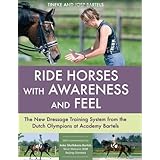
Average Reviews:

(More customer reviews)I just finished this book, and the ending was a big surprise. The authors use a training technique they call Question and Answer, which is the pressure and release training technique used in Natural Horsemanship given another name. That particular technique is very good for the horse and using it is a highly tactful way to train: I use it myself with great success. The authors describe their Q&A method well, and explain why it works: obviously, they have the horse's best interests in mind as they train.
I saw pictures of their mare Sunrise dotting the pages of the book, and her presence told me a lot about the authors. Sunrise was at the 2007 FEI World Cup in Las Vegas and I was very impressed by her: she was obviously strongly in season, but was able to keep herself together in spite of it, with all kinds of other horses around, including stallions. For the authors to have trained Sunrise so that she could perform so well while under stress said a lot about the effectiveness and tactfulness of their methods.
So I was very surprised when I reached the end of the book and found a chapter detailing another part of their training method that they call riding Deep and Round. Deep and Round is nothing but a euphemism for rollkur, and I couldn't believe that trainers that profess to keep the horse's best interests as a primary goal could subscribe to the use of rollkur in training.
The entire chapter about Deep and Round sounded like an attempt to sway the reader's mind about the use of rollkur, since they certainly know what the classical horsemen think of it. Statements that purport that rollkur isn't bad if used by an excellent trainer flies in the face of professionals--vets and trainers--that say just the opposite. Books like TUG OF WAR by Gerd Heuschmann bring the physical facts of rollkur to light, and it's not a pretty picture.
The authors say that their Deep and Round techniques must be introduced to the horse very slowly, and if used properly the horse if happy to do it. Well, you could get a horse to do anything, even tolerate being smacked in the head with a two-by-four, if you did it slowly while giving it a lot of rewards. Horses are such forgiving and cooperative animals that they allow humans to do things to them that are completely against their instincts and well-being, and rollkur is just one of those thing.
This book started out well, and I would have given it five stars if not for the end chapter about the "benefits" (?) of rollkur. Their Q&A training method DOES work, and it treats the horse as the intelligent, sensitive animal that it is. But the rollkur chapter ruined it for me. If you can completely ignore that chapter, the book would be better for it.
Click Here to see more reviews about: Ride Horses with Awareness and Feel: The New Dressage Training System from the Dutch Olympians at Academy Bartels
The common belief that riding a horse can happen effortlessly and naturally is dispelled in this training method from one of the world's leading schools. The method teaches that riding is an activity that must be learned by both horse and rider through a conscious awareness that ultimately will become a subconscious ability, once the modern equestrian gains a "feel" for riding. Not purely a technical endeavor, a feel for riding is developed by learning to communicate with a flight animal and a herd animal, developing self-knowledge and self-control, developing body control, body language, and an independent seat, and learning to give effective aids by training with "questions and answers." Covering the important points that classical literature overlooks, such as the being of the horse and rider psychology, this revolutionary methodology will help a rider achieve awareness and feel in the saddle.

No comments:
Post a Comment